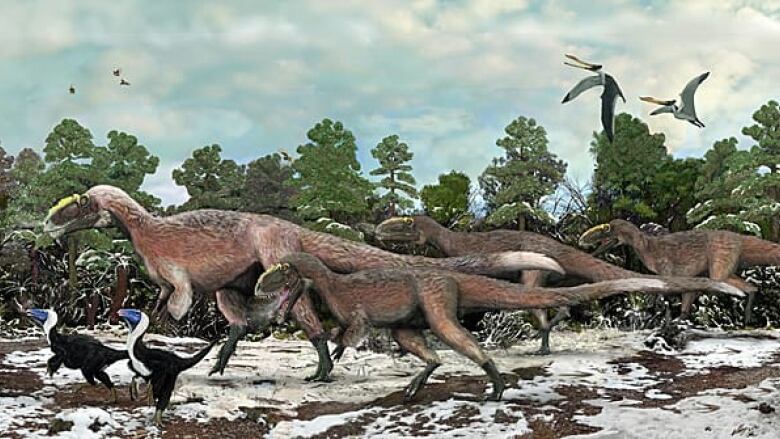Huge, feathered tyrannosaur surprises researchers

A toothy, two-legged dinosaur nearly as long as a school bus is by far the largest feathered creature ever discovered.
The new species of tyrannosaur, which grew to a length of nine metres and weighed 1,400 kilogramsabout three times more than a mooselived in northeastern China about 125 million years ago, during the Early Cretaceous, reports a paper published by Chinese and Canadian researchers in Nature Wednesday.
Long, hair-like feathers could be seen on the bodies of three fossil specimens found in a quarry in China's Liaoning Province.
The feathers were likely used for insulation in the cool climate of the middle Early Cretaceous, when the temperature averaged about 10 C in the region, the researchers suggest.

Lida Xing, a University of Albertagraduate student who drew and labelled the anatomical illustrations in the paper, said the feathers could be clearly seen on the necks and tails of the fossils. It is possible that they covered the dinosaurs' entire bodies, but were simply not preserved in other areas.
Xing's master's thesis is being co-supervised by Xu, who invited him to take part in the study because he had previously done other illustrations for Beijing's Institute of Vertebrate Paleontology and Paleoanthropology.
The dinosaur, named Yutyrannus huali, which means "beautiful feathered tyrant" in a combination of Latin and Mandarin, is 40 times more massive than the largest feathered dinosaur known before, Beipiaosuarus.
Because feathers are widespread among fossils of smaller, related dinosaurs in China and England, some scientists had suggested that larger tyrannosaurs might also have them, said Xing.
Other scientists hadn't expected to find feathers on such a large dinosaurs, since larger animals tend to retain heat much more efficiently than smaller ones, even without insulating hair or feathers.
"That makes Yutyrannus, which is large and downright shaggy, a bit of a surprise," said Corwin Sullivan, a Canadian researcher based in China who co-authored the study.
T. rex lived in warmer climate
Fossils of larger tyrannosaurs, like Tyrannosaurus rex, show that they had patches of scaly skin. However, they lived about 50 million years later, during the Late Cretaceous, when average temperatures were much warmer, closer to 18 C. It is also possible that they had patches of feathers on some parts of their bodies.
Xu said the new discovery suggests that feathers may be more widespread among meat-eating dinosaurs than scientists previously thought.
Besides feathers, the new dinosaur has one other notable featurea wrinkled crest running from its nose to its forehead. Xing said that is a very unusual feature among tyrannosaurs. He suggested it might be used by males to impress females.
The fossil specimens of the two dinosaurs include two crested adults who were found together. The researchers were unable to tell whether they were male, female or one of each. However, Xing said the fact that they were found so close to one another suggests they were social animals who may have hunted or lived together.












_(720p).jpg)


 OFFICIAL HD MUSIC VIDEO.jpg)
.jpg)



























































































